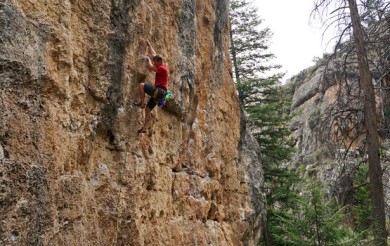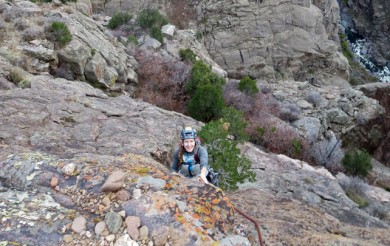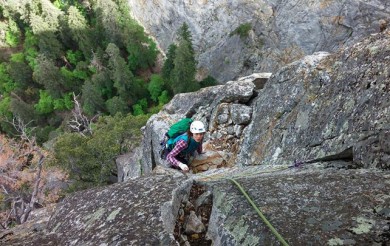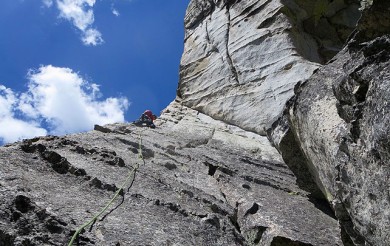Do First Ascentionists Own The Rock?
 A comment on a recent post about upgrading old routes got me thinking about the somewhat absurd notion that many climbers have, in this country anyway, that somehow the first ascentionist owns the rock. Once the first guy does it, nothing short of a congressional mandate can change or alter the character of that climb.
A comment on a recent post about upgrading old routes got me thinking about the somewhat absurd notion that many climbers have, in this country anyway, that somehow the first ascentionist owns the rock. Once the first guy does it, nothing short of a congressional mandate can change or alter the character of that climb.
I was recently having this conversation with a good friend of mine, who is a well respected climber that has established routes all over the world. He thinks this attitude is ridiculous, and he recounted a funny story about climbing at Tahquitz one day and running into John Long, a friend of his. John had just done some sparsely protected 5.10 and commented that somebody should fix that route because “it was dangerous and somebody could get hurt.” My friend replied, John, isn’t that your route? He said, yeah, but we were kids then, we didn’t know what we were doing. I wonder how many other dangerous routes out there are a result of the same kind of thing?
So how does this attitude manifest itself at climbing areas across the country? In most places, the FA is the only person who can “ok” a change to “their” route. How many times have you heard, we got permission from the FA party to add a bolt?
At the other end of the spectrum you have a place like Rifle, Colorado, where the community rules. If a bolt is in a bad spot and should be moved, it gets moved. If there is a dumb runout, it’s eliminated. No one calls up Johny Washed Up Sport Climber to beg for his permission, the work just gets done and the end result is a better rock climb.
Generally, the history of the area dictates the protocol. Rifle is a sport crag, through and through, and as such there is a more progressive attitude when it comes to route maintenance. At a place like Yosemite, it would be a huge deal if a bolt was moved or added to existing routes, and so the FA must be consulted, the community discusses it, and an opinion is formed. Sometimes there is no consensus, and this is usually where the problems begin. The bolt at the start of Double Cross in Joshua Tree is a good example of this. Some feel it’s important, others disagree, so the bolt comes and goes.
How did we get here? For much of the last thirty years, the people putting up routes have been held in high esteem, if not for the quality of their routes at least because they had the vision to go where no others had before. In most areas, the group is small and tends to police itself. But the truth is that people who establish routes are human, just like the rest of us, and they sometimes make mistakes.
In modern climbing, meaning routes that are currently being established, I would argue the end product is much more important than the style of the first ascent. I can think of several major climbing areas out there with “sport” routes that are really lame because they were put up ground up, to adhere to some “climbing ethic,” and the end result is a crappy route with poor bolt placements, bad falls, etc. If those climbs were instead put up with the end product in mind, they could have been much better routes.
And let’s make it clear I’m not talking about going back to well established classics that were put up in a bold style and dumbing them down. We’re talking about developing new climbs that are generally being put up for others to enjoy, not to make a statement about a particular style (although that does still happen from time to time.)
The bottom line in my mind is that when a route is established these days, it should be done in such a manner that it offers the finest experience it can. So if it’s a sport route, that means good clipping stances, safe falls, etc. If it’s a trad route, that MIGHT mean that where you need it the gear is good, with runouts on the easier sections. Or it could be a runout horror show that you have to step up to only when you know you are ready for it. I would also argue that creating a route for others to enjoy is much more important than the one experience the FA had. Or go ahead and have your first ascent adventure, but then leave the route in a state that others will get satisfaction from, not look up and shake their heads at what could have been an otherwise excellent climb.
So does the FA own the rock? I think as a generally courtesy they should be consulted on most matters regarding the status of their routes, but the community should play a large part in dictating the ethics and acceptable style for each area. What do you think?
14 Responses to Do First Ascentionists Own The Rock?
Bulldog Creek Dog Walk (IV WI 4+)
Hayden Carpenter and Tom Bohanon recently repeated an obscure ice climb on the south side of Mt Sopris. Given a brief mention in Jack Robert’s ice guide, Bulldog Creek Walk is described as being 100 meters of WI 4. What they found was seven pitches of ice in a remote setting that makes for one […]
Connect with Us















I think I would tend to agree. I think courtesy is important here. I would say it’s preferable to talk to the person who did the FA if possible and see what he thinks, but in the end, the rock is independent of him, and it’s independent of everyone. It’s a cliff on public land, and if the local climbers decide a climb should be changed, maybe it should. Yeah, the FA is an art form, but are the bolts the art, or is it the fact that you picked out the line and now others want to climb it? Do we climb for the bolts or for the rock?
This is an incredibly slippery slope with potential to lead to bolt wars and lost access. The FA ethic may not be perfect, but it tends to prevent such issues from reaching those unfortunate depths. I agree, however, that local climbers should decide local issues.
In my experience it’s been people operating independent of the community consensus who create bolt wars. The lone wolf who disagrees with the way things are heading so he goes out and chops an entire crag that the community deemed acceptable. I’m not saying people should go out and alter routes as they see fit, I’m saying the FA doesn’t own the rock, the public does and as such, they should have the final say.
BJ, I like the way you put it. As they put it on Mountain Project, rule #1 should always be “don’t be a jerk.” Things should not be done solely out of self-interest, but in the best interests of the climbing community.
Pingback: News & Notes – 3/29/2010 | ClimbingNarc.com
Ultimately it comes down to the end product versus the style? Like the super-duper bottom-line? Like this is the end of the discussion? Thank God then for this contribution. The issue is settled.
Nah, I’m kidding.
This essay’s topic is relevant and interesting, but the essay is pitifully argued and, for the future of climbing culture, extremely unimaginative.
Pitting ‘style’ versus ‘end product’ is a lame distinction when you don’t clarify what these terms really mean to you. Not that it’s not obvious where you stand, and what your preferences are.
Since you’ve conflated the questions of route authorship and ownership with questions of style and community rules I’m going in the direction of questions of style and rules.
It’s not that I have a problem with one style or the other. In fact, I climb and establish well-bolted, well-planned sport routes, and I climb and establish ground-up, protected-on-the-fly traditional routes. I enjoy both! On one day I’ll be thankful for a well-placed crux clip that saves my redpoint and gets me to the chains. On another day I’ll relish the fear, inefficiency, and spontaneity it takes me to grovel to the tree anchor on a traditional climb.
On no day however will I enjoy or agree with the view that all climbs must be established one way.
What befuddles me is the strong, righteous feeling people have that it must be one way or the other. I take as a starting point that there are some people who like to climb one way, and other people who want to climb another way; since that’s the case both have to be okay with me because who am I to decide which style is better?
So show more of your cards before you use a weak distinction to dump on a style that you just don’t like. You’ve loaded your essay ahead of time with a bias which seems to be for one area and one region’s route development preferences. Will you just dismiss others’ preferences to do it a different way, or will you make an genuine attempt to allow for other methods?
(Of course, this is all besides the direct question of ownership. My brief reply would be to start by saying, when climbers talk about ownership they don’t mean it legally. So it doesn’t really help to remind us that such-and-such public entity is the real land owner and therefore route development and ownership is really decided for and by the public, not the individual who created the route. This take on the matter doesn’t even really hold up or settle anything anyway since in the case of privately owned climbing areas the question of ownership still remains a hot topic.)
@climbingislove Thanks for such a well thought out comment. I do have to say you wrongly assume I have a problem with other styles, or believe that every area should adhere to the same set of “rules”. This discussion was started based on the comments of old route developers who regretted having put up these runout routes in the South Platte because no one climbs them anymore. So my point was that if these routes were not being climbed, is it ok to upgrade them in a way that kept them adventurous but made them more accessible to the masses, like a bolt every 15 feet instead of 30 or 40? And who decides that, the FA or the community?
I also enjoy a variety of routes, from safely bolted local choss to the adventure climbs of the Black Canyon, and I’m fortunate to live in a place with so many different styles of climbing close by.
Perhaps I should have been more clear about the end product being most important (and I’ve since edited the original post to reflect that.) In that regard, I am referring to routes that are currently being established, not climbs that were opened up in the 70’s. I can think of several major climbing areas out there with “sport” routes that are really lame because they were put up ground up, to adhere to some “climbing ethic”, and the end result is a crappy route with poor bolt placements, bad falls, etc. For those climbs, yes, I would say if they were put up instead with the end product in mind, they could have been much better routes. I’m not saying don’t put up more adventurous climbs, I’m saying when a route is established, it should be done in such a manner that it offers the finest experience it can. So if it’s a sport route, that means good clipping stances, safe falls, etc. If it’s a runout trad route, that might mean that where you need it the gear is good, and the rest is thoughtful and committing.
And as for your last comment, here in the West there are VERY few private climbing areas, so it really is the community who should be deciding what is and isn’t ok at a local area, not a couple lone wolf first ascentionists. This hasn’t been a major issue so far in the history of climbing, but as more and more restrictions are placed on bolting (and they will be), the community will have to come together more so than ever to present a unified stance to land managers, and show that we can indeed police ourselves.
By this logic, the B-Y should be sport bolted because it has some “dangerous sections where someone could get hurt.” (No disrespect to JL).
Bring yourself up to the level of the route, don’t bring the route down to you. Can’t climb it? Too scared? Choose another climb.
The door swings both ways. “Growing up” on Half Dome was rap bolted and the ensuing shit storm was of epic proportions. If you can climb the same route ground-up, feel free to yank all the bolts you want. Ground up is the established ethic in the Valley. Not so at Smith or Rifle etc.
@Ian The point with the John Long story was that they didn’t intentionally put up the route in that style, they were just kids and did it the best way they knew how, which he later conceded wasn’t “good”. On the B-Y, Bachar knew exactly what he was creating and what it would stand for, and as such it will always be a route that requires your very best.
Again, I’m not advocating everything be sport bolted, merely the idea that FA’s aren’t gods and sometimes they screw things up.
Look, I get what you’re putting down, but you’re just not resolving anything. You’re merely restating the fact that you like some routes, you don’t like others, and because of that the ones you don’t like shouldn’t exist. What you’re avoiding is the plain fact that some people like the routes for the SAME REASONS you don’t like them. These people think these routes should exist for the SAME REASONS you don’t think they should exist. You see what I mean? That’s why when you say the bottom line is that routes should be optimized for the ‘finest expereince,’ I’m sitting here frustrated, wondering, “What the fuck–whose fine experience?” In short, the bottom has fallen out of your bottom line. So, why can’t different styles, and their attached and different set of values, be allowed to exist?
@climbingislove I’m guessing it’s just something we will never see eye to eye on, agree to disagree? And I can’t stress enough that I’m not making a blanket statement about routes “I don’t like”, I’m saying sometimes FA’s screw up and it’s ok for the community to decide what to do with it rather than wait for approval from the almighty FA. (Obviously this mostly applies to bolted sport climbs.) Sorry if I am not getting my point across clearly, I can’t afford an editor 😉
And besides, this is just one person’s opinion, having seen first hand some routes that are generally accepted to be “bad” for a given area. Your mileage may vary.
Read the comments on this page for an interesting debate regarding adding bolts to existing routes, FA ethics, etc. Kind of makes me sick… Lots of egos involved: http://www.mountainproject.com/v/utah/san_rafael_swell/san_rafael_swell_south/105818323
Cimbing today is vibrant and diverse. It is this way because of the great variety of rock types we climb on, the randomness of the features we connect upon these rocks to make our climbs, and yes, the unwritten rules we abide by and the different styles employed by the individuals who climb these routes for the first time. The first ascent ‘rule’ preserves this diversity. If every generation was to change the routes because they know better than the one before, would the world of climbing be better? Of course not, for so many reasons it’s not realistic to start into it. Just use some imagination as to what would become unleashed by this. Climbing is pretty good the way it is, warts and all.
Jonny Woodward.
I’m going to have to agree with Jonny on this one with some caveats. I for one think that the original style should be respected. Too many classics are becoming greasy sweat piles greatly degraded from their original condition due to massive traffic. Rebolting routes to make them more popular simply leads to more ascents. Build it and they shall come as it were, when making freeways, and the resulting environmental impact.
As well, as much fun as I have had sport climbing too there are place like ORG when I have done dozens of routes that are all the same. Excellent climbing, but just another nondescript clip up…whereas a rock climb that challenges your head as well as your fitness, maybe requires some gear placed intelligently…is far more memorable…and route traffic is self limiting to those who dare.
However, if the FA laments that he cannot find anyone to share his experience because the route is so rarely climbed then retro-bolting may be acceptable. I propose a solution: Make the original bolt hangers all one color, the retro-bolt hangers another. Subsequent parties can then still see and appreciate the boldness of the FA (recognizing the few that were used) but then use the retro bolts too.
This would work nicely as a compromise on Powerfinger for example so that people would always know the route was lead without the 5th bolt, but the FA party in fact placed that one (in this particular case) when it is properly restored. Given social media (like MP) this sort of historical detail that would overwhelm a guidebook author can be maintained by the interested parties. If people simply didn’t care it would be on them to be so shallow. If this ever became convention than people would recognize it even without guides or other documentation.